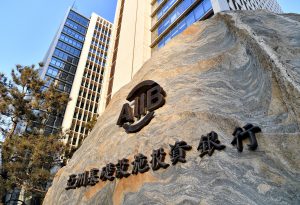The trend for global financial institutions and companies to divest from coal is gathering pace. Though some Chinese institutions have responded verbally to this, policy changes have so far been lacking.
On 9 September, the Asian Infrastructure Investment Bank (AIIB) again stated it was pulling out of the coal sector. The bank has always been seen as somehow Chinese, despite now having 103 member countries, and the announcement has raised hope that China’s global energy investments may be set to decarbonise.
Another no-coal pledge
The latest pledge came from the AIIB’s president, Jin Liqun, at the annual meeting of the Climate Bonds Initiative: “I am not going to finance any coal-fired power plants” he said. “More than that, AIIB will not finance any projects that are functionally related to coal – for instance roads leading to the plant or transmission lines serving coal power.”
A multilateral development bank, the founding of the AIIB was initiated by China at the end of 2015, two weeks after the adoption of the Paris Agreement. It has always described itself as committed to implementing that deal. According to a 10-year strategy issued in October, the AIIB aims to increase the proportion of its climate finance to 50% of actual financing approvals by 2025. The bank’s own figures put that proportion at 35% during the first three years of its existence, and 39% in 2019.
When founded, the AIIB said it aimed to be “lean, clean and green” – but observers say its performance so far has been disappointing.
The September commitment is not the first the bank has made. In June 2017, Jin Liqun said “there are no coal projects in our pipeline” and, ambiguously, that “we will not consider any proposals if we are concerned about their environmental and reputational impact”. This has often been seen as a first “no-coal” pledge. The bank’s vice-president, Thierry de Longuemar, was clearer, telling Agence France-Presse that same month: “There are things it won’t finance, like coal-fired power plants.” But then last year a senior energy policy specialist with the bank said: “We only support coal in countries where there is no alternative.”
Recourse, an organisation that campaigns for international financial institutions to divest from coal, has found that while the AIIB has not invested in coal directly, it has done so through intermediaries. In 2017, it invested US$150 million in the International Financial Corporation’s Emerging Asia Fund. The next year, that fund invested in the expansion of a cement plant owned by Shwe Taung, a Burmese cement-maker, which included a new coal-fired kiln, nearly quadrupling the plant’s greenhouse gas emissions, according to IFC’s own estimate.
And the AIIB remains a generous investor in other fossil fuels.
Recourse’s statistics show that 20% ($3.8 billion) of the bank’s investments were in the energy sector, as of July 2020, with 54% of those being in fossil fuels, and only 24% (over US$900 million) going to renewables.
Commenting on this, Chinese thinktank Greenovation Hub said the AIIB’s investments in the energy sector did not live up to the public’s higher expectations for multilateral bodies, and that it should “direct development and public funds towards clean and environmentally friendly sectors.”
Given the AIIB’s past performance, NGOs and observers have responded cautiously to its new commitment. The bank’s Energy Sector Strategy has not been updated, still reading: “Carbon efficient oil- and coal-fired power plants would be considered if they replace existing less-efficient capacity or are essential to the reliability and integrity of the system, or if no viable or affordable alternative exists in specific cases.” Nor has the AIIB produced, as hoped, a systematic strategy for its response to climate change. The latest draft of its Environmental and Social Framework, which has just finished public consultation, lacks quantifiable targets or ambitions in its language on climate change, and does not even mention coal or fossil fuels.
By way of contrast, the Inter-American Development Bank (IDB), another multilateral development bank which is committed to implementing the Paris Agreement and invests mainly in developing nations, published its own Environmental and Social Policy Framework on 16 September, stating that it would not invest in “thermal coal mining or coal-fired power generation and associated facilities.”
Overseas coal-fired power [plants] with investment from China emit 235 million tonnes of carbon dioxide every year – 2.6% of all power sector emissions outside China
Commenting on doubts about the commitment, an AIIB spokesperson told China Dialogue: “AIIB’s staff will follow the president’s direction when considering energy and transport projects. However, the Energy Sector Strategy remains AIIB’s official position on coal power at this time.”
Rayyan Hassan, executive director of NGO Forum on the Asian Development Bank – a network of civil society organisations that monitors the ADB and other development banks – said a dialogue between NGOs and AIIB executives in late October showed Jin Liqun’s statement did not reflect a consensus among bank management.
Recourse’s campaigns manager, Petra Kjell, said: “This is a missed opportunity, and contrasts sharply with the Asian Development Bank working with other multilateral development banks on observing the Paris Agreement, with the AIIB continuing to lag behind.” Kjell thinks that as China took the lead in setting it up, the AIIB has an important role to play in influencing Chinese policy on overseas energy investments – conditional on its putting its verbal promises into policy documents and keeping “such policy consistent”.
China’s rush to invest in overseas coal
It remains to be seen if the AIIB’s statement on ditching coal will set an example for Chinese banks heavily invested in the sector.
According to statistics from the China’s Global Power Database, launched recently by the Global Development Policy Center at Boston University, between 2000 and 2018 Chinese firms and policy banks invested in or provided financing for at least 777 overseas power projects. Coal projects, which account for 40% of these projects’ generating capacity, are found mainly in Southeast Asia, South Asia and Africa. Three policy banks – China Development Bank, Exim Bank of China, and Agricultural Development Bank of China – were involved in financing 73% of those projects, significantly more than foreign direct investment from China, which was more focused on natural gas power generation.
The centre’s statistics show that 43% of the overseas power generation capacity with Chinese investment and development finance are in lower-middle and middle-income countries, and this investment is crucial for meeting rapidly expanding power demand. But an excess of coal-fired power projects is hampering global efforts to combat climate change. Overseas coal-fired power capacity with investment from China increased by 34% a year between 2009 and 2018, and those plants now emit 235 million tonnes of carbon dioxide every year – 2.6% of all power sector emissions outside China, and more than half Brazil’s total fossil fuel emissions for 2017. If all China-invested coal power plants currently planned or under construction are in operation by 2030, emissions will reach 433 million tonnes a year.
In contrast, only 11% of China-invested overseas power capacity is non-hydropower renewables. While that sector is growing faster than coal, at 46% a year rather than 34%, actual capacity still lags far behind.
It is hard to gather data on overseas coal power investments by China’s commercial banks. But research by the Global Development Policy Center and the World Resources Institute shows that China’s four major state-owned commercial banks and two policy banks often participate in syndicated coal power loans in countries covered by the Belt and Road Initiative. Between 2009 and 2018, these six banks were involved in $10.2 billion of such loans.
Those state-owned commercial banks have plenty of experience with coal power investments. The Industrial and Commercial Bank of China, Bank of China, China Construction Bank, and Agricultural Bank of China were the four biggest bank financers for the 30 top coal mining companies and 30 top coal power companies. Yet none of these banks has clear policies on limiting investments in coal.
Substitution risks
Japan and South Korea were both once active investors in overseas coal power. But unlike China they have recently shifted their stance. In July, the Japanese government said it will, in principle, scale back on such investments, although details are not yet clear. The same month, MPs of the ruling party in South Korea put forward a bill which would ban investment of public funds in overseas coal projects. In September, KB Kookmin Bank, one of the country’s four biggest banks, announced an end to funding for coal power both at home and abroad, with an increase in green investments. In November, Samsung Group’s key insurance affiliates pledged to end investment in coal-power-related projects and purchase of bonds issued for the purpose of building such projects.
According to a 2017 analysis by the Global Environmental Institute, since 2013 many major international financial bodies have stopped funding coal power plants – leading some countries to turn to China for support.
“Some countries are very keen on building coal power, as they see it as reliable and cheap, and so Chinese investment better meets local power needs,” said Liu Shuang, senior associate with the World Resources Institute.
More than half of all Chinese coal plants are already running at a loss today, and this trend is only going to continueDurand D’souza, Carbon Tracker Initiative
“China’s coal power industry has certain technical advantages and is confident it can meet overseas demand, which to an extent has influenced investment bodies,” added Miao Hong, also of the WRI. She says renewables in China has been developing strongly and is moving towards a subsidy-free era – and China should use regional cooperation to export that experience, helping other nations find low-carbon alternatives.
China has been issuing policies along these lines. In October, five government bodies, including the Ministry of Ecology and Environment, published guidance encouraging financial institutions to expand investments in non-fossil energy. Although this did not include restrictions on investments in fossil fuels such as coal, the documents did call for encouraging financial institutions to boost decarbonisation in countries covered by the Belt and Road Initiative and the South–South Cooperation framework and promote overseas climate change mitigation and adaptation projects. It also encourages the use of social responsibility frameworks for overseas investments in order to avoid and mitigate climate risks.
Given China’s recent pledge on carbon neutrality, Simon Zadek, chair of Finance for Biodiversity, a campaign of almost 30 financial institutions from around the world, said that alongside accelerating the shutdown of coal power at home, the Chinese government must prevent high carbon energy generation spreading through the BRI if its commitment is to make a real difference to global emissions.
BRI nations have seen coal as a reliable and economical source of power but are now re-evaluating. Bangladesh, for example, has recently announced it will reconsider 26 of the 29 coal power plants it is planning to build. Analysis suggests the country may start a decarbonisation transformation.
This means Chinese financial institutions have to be wary of the risks associated with overseas coal investments.
Durand D’souza, a data scientist with the Carbon Tracker Initiative, warned that “more than half of all Chinese coal plants are already running at a loss today, and this trend is only going to continue. Meanwhile, renewables and battery storage costs continue to fall and undermine the case for coal. This story is playing out in all BRI countries as well, calling into question the need for coal-power financing abroad.”
“Chinese institutions should be more aware of the risks of building coal power abroad,” said Liu Shuang, “and when appropriate be confident enough to shift to a no-coal strategy, as international institutions have done.”







